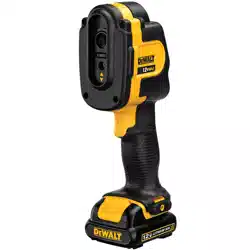Loading ...
Loading ...
Loading ...

13
English
NOMINAL EMISSIVITY VALUE
MATERIAL VALUE MATERIAL VALUE
Carbon-filled surface 0.98 Copper, heavily oxidized 0.78
Frost crystals 0.98 Cloth, cotton 0.77
Human skin 0.98 Sand 0.76
Slate 0.97 Silica, unglazed 0.75
Water, distilled 0.96 Iron, oxidized at 100˚C 0.74
Ice, smooth 0.96 Coating No. C20A 0.73
Soil, saturated with water 0.95 Basalt 0.72
Carbon candle soot 0.95 Carbon, graphitized at
500˚C
0.71
Glass, polished plate 0.94 Red Rust 0.70
Paint, oil 0.94 Iron sheet, heavily rusted 0.69
Brick, red 0.93 Water 0.67
Paper, white bond 0.93 Black loam 0.66
Concrete 0.92 Cement, white 0.65
Soil, dry 0.92 Iron cast, oxidized 0.64
Plaster, rough coat 0.91 Lead, oxidized at 1100˚C 0.63
Wood, planed oak 0.90 Zirconia on inconel 0.62
Earthenware, glazed 0.90 Cu-Zn, brass oxidized 0.61
Snow, granular 0.89 Inconel sheet at 760˚C 0.58
Silica, glazed 0.88 Marble, smooth white 0.56
Cuprous Oxide at 38˚C 0.87 All anodized chromic acid 0.55
Emery Corundum 0.86 Iron cast, polished 0.21
Snow 0.85 Brass, rubbed 80 grit emery 0.20
Stainless, oxidized at
800˚C
0.85 Stainless steel, 18-8 buffed 0.16
Iron, oxidized at 500˚C 0.84 Aluminium as received 0.09
Cuprous Oxide at 260˚C 0.83 Steel, polished 0.07
Snow, fine particles 0.82 Aluminium, polished sheet 0.05
Brass, unoxidized 0.81 Copper, polished 0.05
Glass, convex D 0.80 Brass, highly polished 0.03
Steel, oxidized 0.79
To Change Emissivity
1. Press the menu/power button (L).
2. Press the forward (J) or back (H) arrow to highlight the emissivity
option in the menu.
3. Press the select button (I) to confirm selection.
4. Press the forward (J) or back (H) arrow to adjust the emissivity
setting. The emissivity can be adjusted in increments of 0.01 from
0.10 to 1.00.
5. Press the select button (I) to confirm the emissivity setting.
6. After saving the emissivity setting, the imaging thermometer will
automatically return to the main menu screen.
Background Temperature
For more accurate temperature measurements, it is recommended
to set the background (or reflected temperature). This is especially
important when the object being measured is at a significantly different
temperature than ambient or if the object being measured has a low
emissivity.
Setting the background temperature will help compensate for the
radiation from the surroundings.
Loading ...
Loading ...
Loading ...
